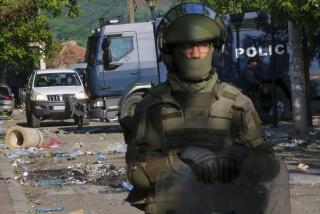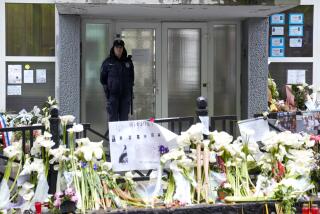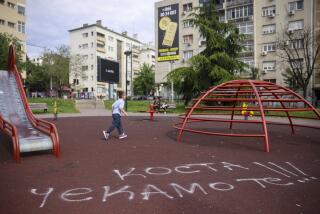Some Serb Arms Are Moved Away From Sarajevo
- Share via
SARAJEVO, Bosnia-Herzegovina — Facing renewed NATO air strikes, Bosnian Serbs moved a fraction of their heavy weapons away from this besieged capital Saturday, while government forces continued a swift march through western Bosnia, ousting Serbs ahead of them.
The United Nations, meanwhile, faltered in its efforts to open another road into Sarajevo when Bosnian Serb objections stopped a convoy of the Anglo-French rapid-reaction force. In a positive development, several more aid flights arrived at the newly reopened airport. But the siege of Sarajevo was still far from over.
After more than two weeks of bombing Bosnian Serb positions, the North Atlantic Treaty Organization declared a 72-hour pause Thursday when the Serbs promised to withdraw their largest guns from a 12 1/2-mile exclusion zone around Sarajevo. Getting the Serbs to move those weapons had been the major goal of the air campaign, but the Serbs had refused to concede.
Thursday’s pledge came in a meeting with U.S. envoy Richard Holbrooke and the president of Serbia, Slobodan Milosevic. U.S. officials have since sought to distance themselves from the agreement after it was revealed that it allows the Serbs to keep in place some of their deadliest artillery and mortar pieces, as well as all antiaircraft guns.
As diplomacy focused on Sarajevo, battle lines were shifting dramatically in the field. The Bosnian government army and its Croatian allies continued to consolidate gains in western Bosnia, sending tens of thousands of panicked Bosnian Serb refugees into flight.
The army was reportedly claiming that it was approaching the Bosnian Serb stronghold of Banja Luka in northern Bosnia. While that could not be confirmed, the Serbs did acknowledge losing the town of Kljuc, 30 miles south of Banja Luka. Another town, Jajce, also about 30 miles south of Banja Luka, fell to government forces last week.
In all, government forces have recaptured about 11% of Serb-held Bosnia in just the past week, a remarkable 1,500 square miles of land that the Serbs had held virtually unchallenged since the start of the war.
The speed with which town after town has fallen has led some military analysts to believe that the Bosnian Serbs for the most part have withdrawn rather than fight--a typical behavior in this war and one made more likely with the NATO bombardment of the Serbs’ communication and command-and-control centers.
Furthermore, the return of this portion of western Bosnia to Muslim-Croat hands coincides with what is likely to be the territorial divide agreed to in ongoing peace talks. The warring sides have agreed to a split, with 49% of Bosnia going to the Serbs and 51% to a Muslim-Croat federation. A map showing who gets what is being negotiated under Holbrooke’s auspices.
Until recently, the Serbs held 70% of Bosnia. Now, some estimates say they are down to as little as 55%.
Bosnian Serb leader Radovan Karadzic, acknowledging major territorial losses for the first time, appeared on Bosnian Serb television Saturday to blame the intervention of the Croatian army for his troops’ defeat.
The offensive triggered a wave of 50,000 to 80,000 Serbian refugees, who fled toward Banja Luka, a city already overcrowded with refugees from the fall of the Krajina, formerly Serb-held territory in Croatia.
People slept outdoors, in the rain, while their tractors and horse carts choked the roads and blocked access to the city.
“The situation is absolutely chaotic,” said Jessica Barry of the International Committee of the Red Cross. “People are milling about. They don’t know where they will go. It is very, very difficult.”
There were unconfirmed reports, which the United Nations was investigating, that each side had committed atrocities against the other. Bosnian television claimed that Serbs killed a group of Muslim and Croatian villagers in the area of Donji Vakuf, a formerly Serb-held town that fell last week, while there were other reports of abuses by government troops. Bosnian military police have blocked U.N. access to the areas in question.
As government forces advanced on western Bosnia, the Serbs began to comply, haltingly, with demands to move their heavy weapons away from Sarajevo. By late Saturday, 43 mortars, artillery pieces and tanks had been moved, a U.N. spokesman said.
The rebels have more than 300 such weapons in the hills around Sarajevo, but a caliber ceiling agreed to by Holbrooke and Milosevic means that one-third would be exempted. They include mortars of 82-millimeter caliber or less and artillery pieces of 100-millimeter caliber or less. Originally, the United Nations and NATO had insisted on withdrawal of all guns with calibers greater than 12.7 millimeters.
Bosnian Prime Minister Haris Silajdzic expressed outrage at the loophole and urged further air strikes if the Serbs refuse to move all their big guns.
“Resolve and determination brought us to this point,” Silajdzic said in a news conference. “We are close to peace but still a large step away. If they [NATO and the United Nations] back down now, we lose the momentum.”
He said the weapons exempted have caused most of the 10,000 deaths registered in Sarajevo in 41 months of war. The Serbs’ practice has been to lob shells into the city from the surrounding hills, hitting people caught unawares as they shopped in markets, waited in line for water or sat in their apartments.
Earlier Saturday, U.N. officials warned that the pace of the weapons removal was too slow and said they doubted that the Serbs intended to comply fully.
“If they are to meet the demand and have a significant number of weapons out [by the 72-hour deadline], they need now to start doing that quickly just to meet the pure military mechanics of moving these vehicles within the time frame,” U.N. spokesman Lt. Col. Chris Vernon said.
Late Saturday, Vernon said the pace had picked up enough so that, if it was maintained, the Serbs might meet the deadline of noon today, local time.
NATO aircraft continued to fly patrols and reconnaissance missions over Bosnia, including some to monitor the weapons movement.
“We’re watching, the U.N. is watching, but what we’ve seen so far doesn’t seem impressive,” commented one NATO official in Brussels late Saturday as dark began to fall over the Bosnian capital.
The Bosnian Serbs have also agreed to allow the airport and two roads between Sarajevo and the outside world to open. The airport has now received humanitarian aid flights, but an attempt to open a road through the Serb-held suburb of Hadzici was postponed Saturday when the Serbs objected to passage by the United Nations’ rapid-reaction force--combat troops that U.N. officials said apparently intimidated the Serbs.
U.N. officials said they thought the Hadzici road matter would be resolved today, but the episode showed that U.N. insistence on unimpeded access to the capital has not yet been satisfied.
“The lifting of the siege is when all civilians can move along all routes to and from the city,” said U.N. spokesman Chris Gunness. “That is a pipe dream at the moment.”
Times staff writer Tyler Marshall in Brussels contributed to this report.
More to Read
Sign up for Essential California
The most important California stories and recommendations in your inbox every morning.
You may occasionally receive promotional content from the Los Angeles Times.














